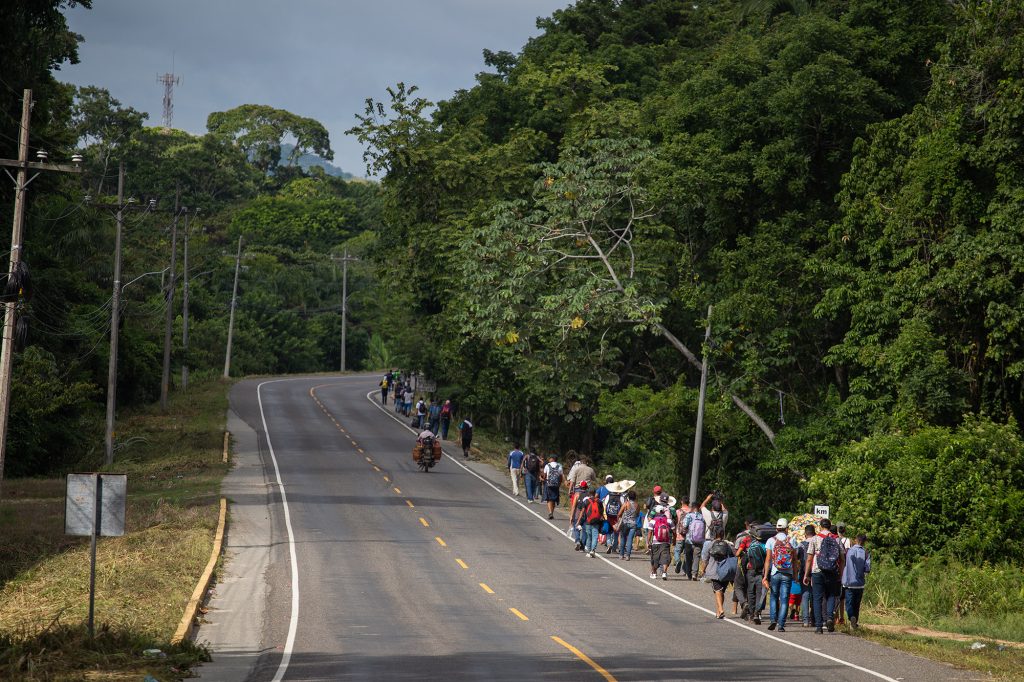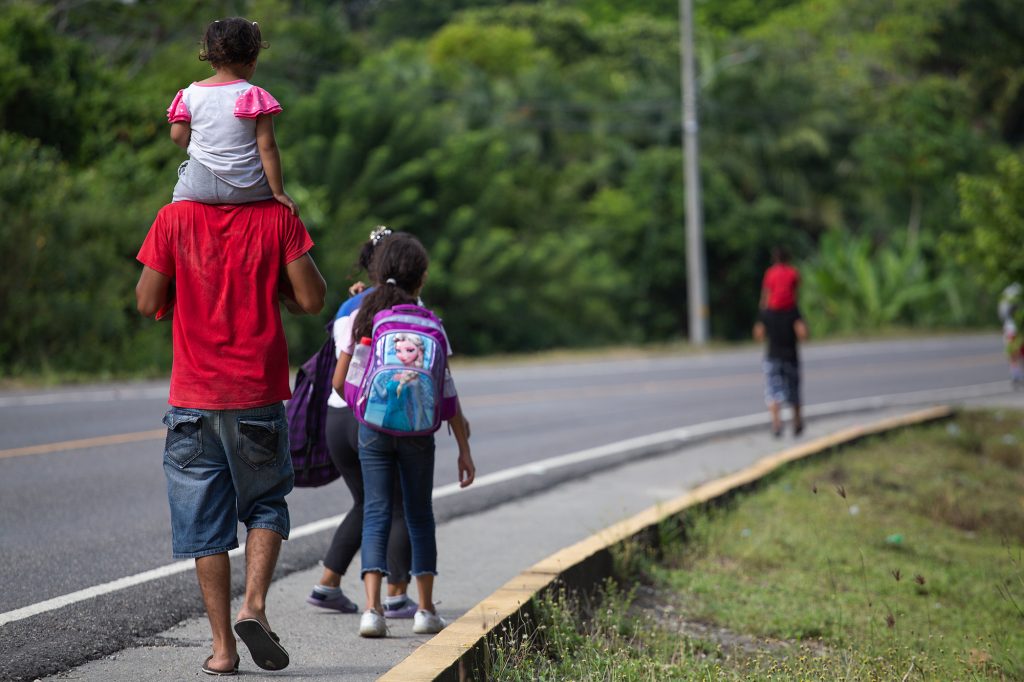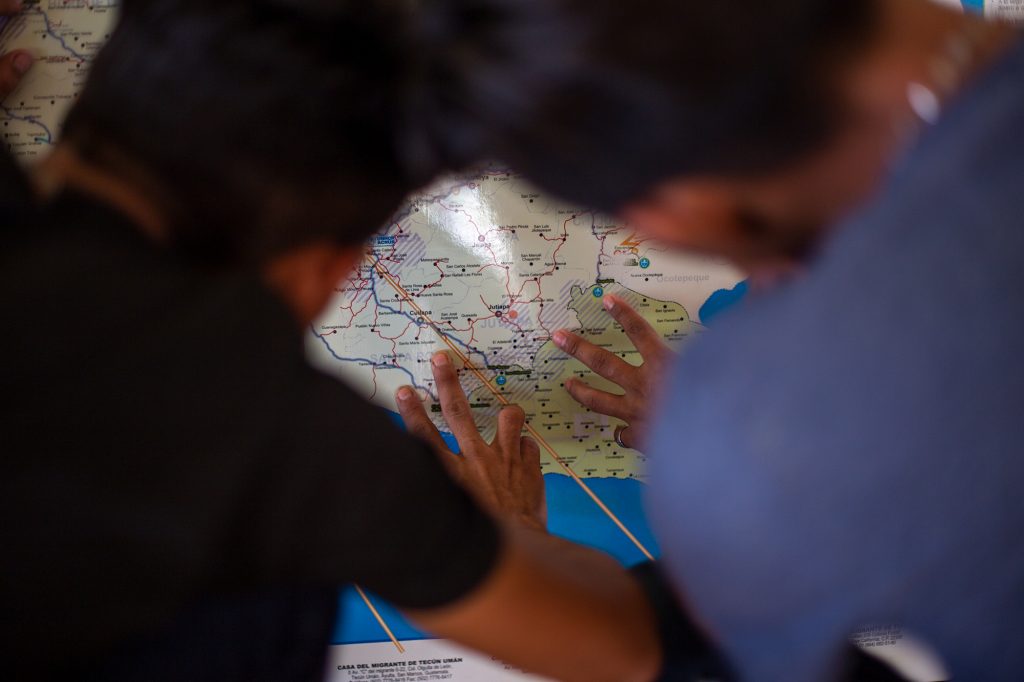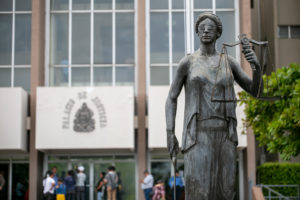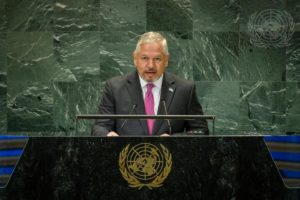A mother’s heart always aches when a child leaves home for some faraway place, especially if they are fleeing their country because it has nothing to offer. But when her child is kidnapped along the way, the pain becomes unbearable and the only thing that keeps her going is the hope of seeing them again. This is the story of a mother who has asked to remain anonymous, because in her case her son has returned to the place he fled, and her fear persists.
By Allan Bu
Photos by Martín Cálix
Aminta (a pseudonym) was watching a Univisión news report on TV when she received a horrifying phone call from her son, Alejandro (a pseudonym). The young man had left home a few days earlier to migrate north, and when she answered the phone he was suffocating in a shipping container abandoned by smugglers. Alejandro was saying goodbye for the last time.
That was the beginning of Aminta’s nightmare. People like her suffer twice – when their child leaves home, and from the hopelessness of knowing their country can’t provide them with ways to survive.
Aminta is 57, and has been an elementary school teacher since she was 16 – more than 40 years of service. She married twice, but now lives alone with her teenage son. Her first husband died, and her second husband abandoned the family and migrated to the United States. She heard nothing from him for more than 10 years, so she turned him away when he returned to Honduras.
Every Honduran family has a migration story, and nothing has changed since Aminta’s husband left. A 2013 study by Vladimir López, a researcher with CIESAS (The Research Centre of Higher Education in Social Anthropology), a Mexican organization, determined that in 1990, 108,000 Hondurans were living in the United States; and by 2010, the number had grown to 633,000.
This number has increased exponentially in the last decade, especially since 2018, when thousands of Hondurans joined massive caravans heading to the United States. The most recent caravan was in 2021 ⎻ not even a pandemic could stop 7,200 Hondurans from leaving the country. In Guatemala, they were beaten and sent home.
According to data from the U.S. Customs and Border Protection agency, migration increased when President Joe Biden took office in January 2021. In February of this year, 100,000 people crossed the U.S. border without formal permission. Most were Mexicans, Guatemalans, Salvadorans and Hondurans. One of them was Aminta’s son, who lived and worked in one of San Pedro Sula’s most crime-ridden areas, where gangs fight for turf and shootouts are a fact of life.
Aminta has two sons; her youngest is studying hotel management and tourism at the university, and her older son trained in auto repair. He was the one who called Aminta while suffocating in a shipping container. To understand how Alejandro ended up in this container, one has to examine the endemic violence and insecurity that are behind such events.
Regardless of how much the government touts its fight against violence and insecurity, the country is still fertile ground for crime. In January 2021, 14 bodies were found in bags dumped in San Pedro Sula, Tegucigalpa, Tela and Choloma with signs on them that read “extortionist.”
“This type of crime isn’t new. But the number of bodies found like this has caught our attention,” said Jaír Meza, a spokesperson for the National Police, in an interview with the EFE news agency.
The violence did not abate in 2020, even when the pandemic brought about months of total and partial lockdown. According to data from the National Police, there were 3,289 homicides in 2020. The Hernández administration has assigned hundreds of millions of dollars to fighting the country’s security problem. The 2021 budget for the Ministry of Security is US$290 million, and US$352 million for the Ministry of Defense.
Alejandro made the decision to leave the country when violence knocked on his front door. He was working as a mechanic in Roatán with a well-known company, while his wife and family stayed in Puerto Cortés, on the mainland. Another employee was fired by the boss after a dispute, but as he was leaving, he threatened to report Alejandro to one of the gangs that terrorize Honduras.
Alejandro soon realized he was being watched. Twice he saw his former coworker and some other men waiting for him near his bus stop. He didn’t hesitate any longer and decided to quit his job and go to the United States.
He left without telling his mother, who thought he was in Guatemala on an errand for his employer. Aminta found out when she called Alejandro’s house one day and her grandson asked, “Grandma, don’t you know that my dad went to the United States?”
Her heart sank as she watched a Univisión news report on TV about a shipping container that had been found with 200 immigrants inside. That’s when she got a call from her son. “Mom, I’m calling to say goodbye, because I don’t think I’ll ever see you again. I’m suffocating,” said Alejandro.
— “Son, are you in the container?” she asked, with a mother’s sixth sense. While they were talking, the TV showed Mexican police cars arriving on the scene.
— “Yes, I’m inside, mom,” said Alejandro.
— “Call the police, son. Let them get you out of there,” cried his mother.
The call ended and Aminta sat watching the TV in anguish. Minutes later, the police opened the container door and as she watched the live report hundreds of miles away, her son jumped out of the container and disappeared into a thicket. “That’s when I knew my son was alive,” said Aminta. When he called again, Alejandro told her he was hiding in the underbrush, but didn’t know exactly where he was. About eight people were with him and he was still heading north.
Three days after watching the shocking scene unfold live on television, Aminta was teaching school when she received a call. She thought it was her son calling with an update. When she answered, a voice said “We are Los Zetas and we have your son. We want US$5,000 and if we don’t get it…” She doesn’t finish the sentence, which was surely a death threat.
They sent some photos and let Alejandro speak to her briefly. She asked for a little time to get the money together. “You don’t have any time. Get it now and don’t think about going to the police because we’ll find out,” they threatened her.
When the phone call ended, she sat quietly for a while, anxious but confident. “I had a little money saved,” she says. But when she wanted to send the money to Mexico, she ran into another obstacle. “The bank wouldn’t let me transfer the entire amount, so some relatives and I sent a bunch of US$20 transactions.”
Her savings exhausted, Aminta bought a few days of relative peace and quiet. Armando was back on the road again, except now his captors were watching over him, and providing food, clothing and shelter.
They were constantly moved from house to house and given tasks to perform. One time they were told to dig a huge hole without knowing why. “You don’t ask questions here,” Alejandro told his mother once. They were allowed to use cell phones for short calls and were given clothes and food. “Those of us who paid are okay. We haven’t seen those who didn’t,” said Alejandro.
Aminta tells the story as if she had been there. She says that when her son’s group reached the northern border, the gang gave him a backpack with unknown contents to carry. “You don’t ask questions here,” Alejandro often said.
The backpack most likely contained drugs; a multi-billion dollar criminal market in the United States. According to a study by the Rand Corporation, People in the US spent US$150 billion on illegal drugs in 2016. Turf wars among drug traffickers have turned Honduras, Guatemala, El Salvador and Mexico into some of the most violent countries in the world.
The brother of Honduran president Juan Orlando Hernández was sentenced to life in prison plus 30 years for drug trafficking by the Southern District Court of New York. Prosecutors frequently named the Honduran president as a co-conspirator in his brother’s trial, and as an associate of drug trafficker Geovanny Fuentes Ramírez during another trial in the same court.
***
Alejandro was now in the United States and the “American dream” was within reach. Then he was kidnapped again. A little over a month had passed since the previous kidnapping, and he was now in the hands of the Escorpiones Negros (Black Scorpions).
The only reference found in media reports to a cartel named “Escorpiones” revealed that it’s an armed faction of the Gulf Cartel, which is engaged in a bloody fight with Los Zetas to control drug trafficking to the U.S. through the Mexican state of Tamaulipas.
Just when Aminta was expecting some good news from her son, she received another devastating call that brought more anguish, fear and threats. “They started to make demands. But I told them, ‘Put him on the phone. I want to hear his voice. We’re going to negotiate.” They demanded US$5,400.
“You’re going to have to wait,” she told the kidnappers. And another race against time to raise the ransom money began. “I told myself that I have to be strong. I have to do anything I can for my son. I won’t just leave him there and never see him again. Lord, give me strength,” she says, crying.
This time she was unable to raise the ransom quickly. It took about 12 days, during which her son was tortured. One day they made a video call to Aminta that tore her heart out. The kidnappers were having a barbecue and her son was tied to a tree. Every time they turned the meat over on the grill, they would burn Alejandro’s back with the hot fork. “He still has the burn marks,” said Aminta.
This cartel also used migrants to transport “stuff” across the border. Aminta tells us that her son was brutally beaten with a bat when he protested. “Then Alejandro was no good as a mule anymore because he began to have kidney problems and became unconscious. They beat him and didn’t give him any water.”
She finally got all the money together with the help of some relatives and a loan from a teachers’ pension fund (Instituto Nacional de Previsión del Magisterio – INPREMA). She took recordings of phone calls and videos with her to solicit the loan. “Don’t worry, we’re going to give you that loan,” she was told.
Once she sent the money, the kidnappers cut off all communication. She found out later that they’d dumped her unconscious son in a forested area. He was found by one of the U.S. Border Patrol canine units and taken to a hospital in Houston.
Back in Honduras, the distraught mother had not heard from her son since she handed over the ransom money. Then she received a call one day when she was teaching a class. It was from the hospital where her son was hospitalized and on the verge of death. “His kidneys were in very bad shape; he had burns and was completely dehydrated,” she says.
She was given a number to call to inquire about her son’s health. They promised to send him home once he was in better shape. At first, he couldn’t even stand up and was hospitalized for about two and a half months. “I saw him all bandaged up. They treated him well in the United States,” she said.
The day she received a call from Ramon Villeda Morales airport [in San Pedro Sula], she knew her son was coming home. She saw him arrive in a wheelchair, more than five months after he left. Aminta is a strong woman, but gets emotional at the memory. Sobbing, she tells us, “That’s when I got my life back, but it’s still very hard.”
According to data from the Consular and Migratory Observatory of Honduras, a project of the Tiempo Digital media outlet, 13,139 Honduran migrants were repatriated in the first three months of 2021. This number is lower than in 2020, when 17,331 Hondurans were deported during the same period.
Between 2017 and 2019, the United States adjudicated 9,000 asylum requests from Hondurans. This data was reported in the migration profile for Honduras developed by the International Organization for Migration (IOM).
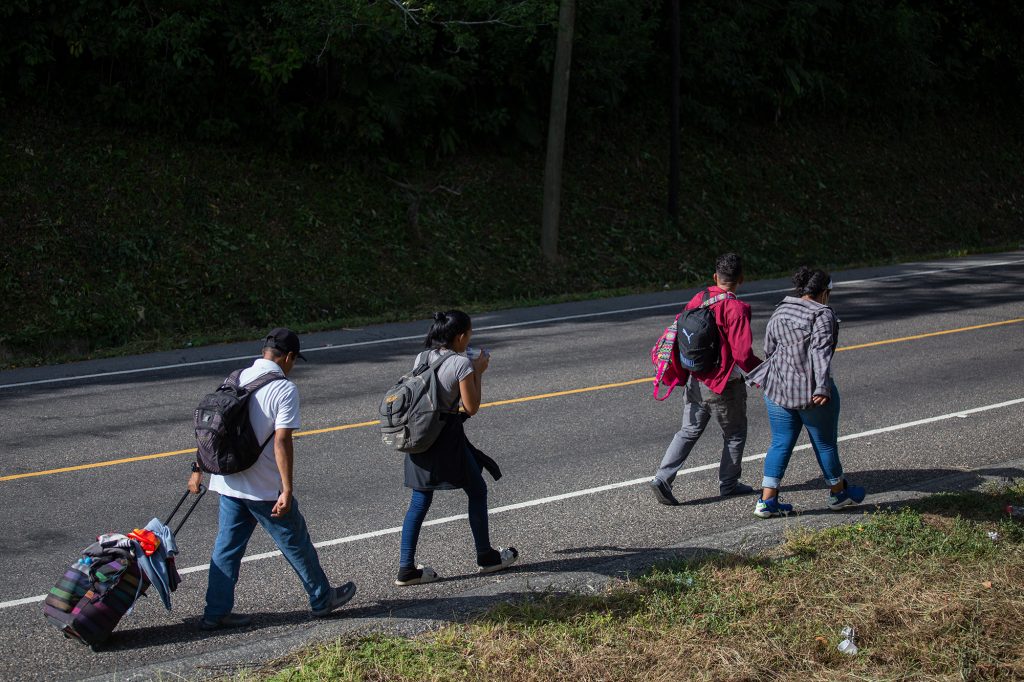
The Chicago Tribune reports that in 2018, U.S. asylum officers conducted credible fear interviews with 25,500 Hondurans, the most of any nationality, according to data from the Department of Homeland Security. Only 9% of those interviewed were not referred to the next stage of the asylum process.
Most Honduran asylum seekers pass the credible fear interview, but just under 11% received asylum from 2009 through 2018, according to a Union-Tribune analysis of immigration court records. About 59% were deported just like Alejandro, even though he was threatened in Honduras.
Despite all this, remittances from Hondurans living abroad sustain the Honduran economy. Data from the Central Bank of Honduras for 2020, a pandemic year, indicate that Hondurans living abroad sent about US$5.5 billion home, which is 20% of the country’s gross domestic product (GDP).
Back home in Honduras, Alejandro needed psychological counseling. Aminta says that it took several days before they were even able to have a conversation. “We couldn’t even talk because both of us were just crying and crying. I lived through some terrible times. I wouldn’t wish that on anyone. It’s one of the cruelest things that can happen to a mother.”
As if needing to illustrate what she lived through, she tells us that she was 55 and had jet black hair when her son was kidnapped. Her hair turned completely gray during the months that Alejandro was held captive. “It was pure pain. You have no idea the things I was imagining. I was glued to Univisión.”
The suffering didn’t end for Aminta’s son when he returned home. “He couldn’t sleep; he was too afraid. When he did manage to fall asleep, he would wake up screaming. This has taken a toll on all of us.” The mother and her son don’t talk about it anymore; he has asked her to turn the page.
Alejandro has a new job and lives with his wife and children, but the wounds still haven’t healed. His mother wishes she could have suffered in his place. “There are some good people, but there are some very bad people. It’s all about money on the road north. The cartels think that migrants have money, and they don’t care if they don’t. You just have to get it.”

